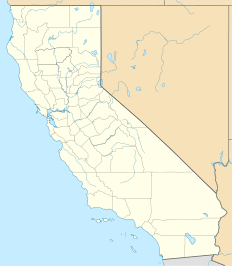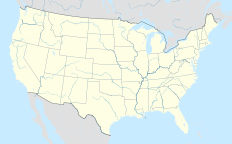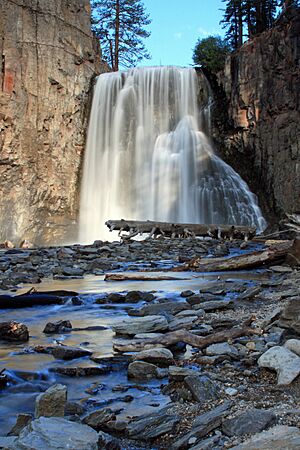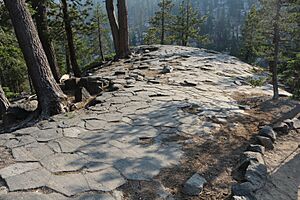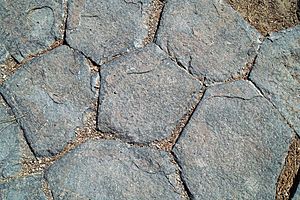Devils Postpile National Monument facts for kids
Quick facts for kids The Devils Postpile National Monument |
|
|---|---|
|
IUCN Category III (Natural Monument)
|
|
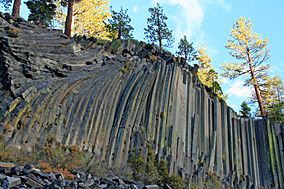
Basalt columns of Devils Postpile
|
|
| Location | Madera County, California, United States |
| Nearest city | Mammoth Lakes, CA |
| Area | 798 acres (323 ha) |
| Created | July 6, 1911 |
| Visitors | 109,571 (in 2017) |
| Governing body | National Park Service |
| Website | Devils Postpile National Monument |
Devils Postpile National Monument is a special place in Eastern California, close to Mammoth Mountain. It is a U.S. National Monument, which means it's protected by the government. This monument is famous for its amazing rock formation called Devils Postpile. It's made of unique columnar basalt rocks that fit together like a giant puzzle.
The monument covers about 798 acres (323 hectares). It has two main attractions: the Devils Postpile rocks and Rainbow Falls. Rainbow Falls is a beautiful waterfall on the Middle Fork of the San Joaquin River. Also, two famous hiking trails, the John Muir Trail and Pacific Crest Trail, meet and pass through this area. Most of the monument is part of the Ansel Adams Wilderness, a wild and undeveloped natural area.
Contents
History of Devils Postpile
The monument was created in 1911. At first, it was called "Devil Postpile National Monument." But over time, people started calling it "Devils Postpile National Monument," using the plural form without an apostrophe. This became its official name in the 1930s.
Some people used to call it "Devil's Woodpile." This was because sheep herders often saw strange rock formations and thought they were the work of the devil. So, this unique rock pile got its name.
Devils Postpile was once part of Yosemite National Park. But in 1905, gold was found near Mammoth Lakes. This led to a change in the park's boundary, and the Postpile ended up on public land outside the park. Later, there was a plan to build a hydroelectric dam. This plan would have meant blasting the Postpile into the river!
Luckily, important people like John Muir, a famous naturalist, convinced the government to stop this plan. In 1911, President William Howard Taft officially protected the area. He made it a National Monument to save it for everyone to enjoy.
Animals and Plants
The Devils Postpile National Monument is located at a high elevation, between 7,200 and 8,200 feet (2,195 to 2,499 meters). The animals and plants here are typical of the western Sierra Nevada mountains at these heights.
You might see animals like black bears, pine martens, mule deer, and coyotes. The area also has many trees like quaking aspen, black cottonwood, alder, and willows. In the summer, birds like Dark-eyed juncos and white-crowned sparrows are common.
Many beautiful wildflowers grow here, including:
- Crimson columbine (Aquilegia formosa)
- Giant red Indian paintbrush (Castilleja miniata)
- Sierra tiger lily (Lilium parvum)
- Large-leaved lupine (Lupinus polyphyllus)
- California corn lily (Veratrum californicum)
How to Visit Devils Postpile
The most common way to get to Devils Postpile is by taking a special shuttle bus. This bus runs during the summer months. The shuttle ride starts at Mammoth Mountain Ski Area's Adventure Center. After the shuttle, it's a short walk of about 1/4 mile (0.4 km) to the Postpile.
You can also hike to Devils Postpile from Mammoth Lakes. You would hike over Mammoth Pass to reach the Reds Meadow Valley. During the winter, the roads are closed, and there are no services. But adventurous people can still visit by cross-country skiing or snowshoeing.
Sometimes, the Reds Meadow Road, which leads to the monument, is under construction. This can affect when and how you can visit. It's always a good idea to check the official park website for the latest access information before you go.
The Devils Postpile Formation
The name "Devils Postpile" refers to a tall, dark cliff made of columnar basalt. Scientists believe this rock formation was created by a lava flow less than 100,000 years ago. The lava likely came from an area near Upper Soda Springs. It then flowed to where the Postpile stands today.
The lava flow was very thick, possibly between 400 and 600 feet (122 to 183 meters) deep. Because this large amount of lava cooled very slowly and evenly, it formed long, symmetrical columns. This process is called columnar jointing. It happens when certain types of lava shrink as they cool down.
Later, a glacier moved over the area. The glacier scraped away much of the rock, leaving a smooth, polished surface on top of the columns. You can still see clear marks from the glacier, called glacial striations, on the column tops.
The columns at Devils Postpile are usually about 2 feet (0.6 meters) wide. The largest ones can be up to 3.5 feet (1.1 meters) wide. Many of these columns are as tall as 60 feet (18 meters)! They look like giant posts stacked together, which is how the formation got its name.
If the lava had cooled perfectly, all the columns would be six-sided (hexagonal). But because of slight differences in cooling, some columns have different shapes. Most are six-sided, but some are five-sided, four-sided, or even seven-sided. What makes Devils Postpile special is that it has more hexagonal columns than many other similar places. Also, these columns don't have many horizontal cracks, which is another unique feature.
Other Places with Columnar Basalt
While the columns at Devils Postpile are amazing, they are not the only ones in the world. Columnar basalt formations are a common sight where volcanoes have been active. Faster cooling lava usually creates smaller columns.
Some other famous places with similar rock columns include:
- Giant's Causeway in Northern Ireland
- Fingal's Cave in Scotland
- Svartifoss waterfall in Iceland
- Sheepeater Cliff at Yellowstone National Park in Wyoming
- Basaltic Prisms of Santa María Regla in Mexico
- Organ Pipes National Park in Australia
It's important to know that the much larger Devils Tower National Monument in Wyoming looks similar but is made of a different type of rock. It formed in a different way, from magma pushing up from underground.
Images for kids


